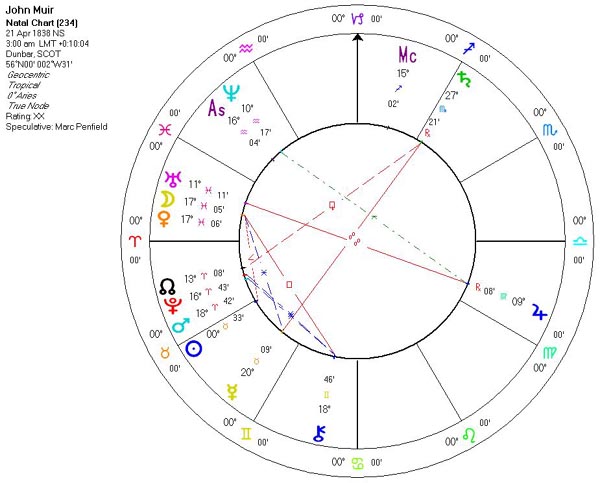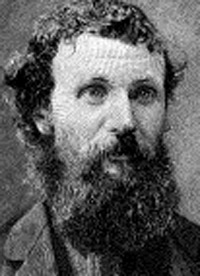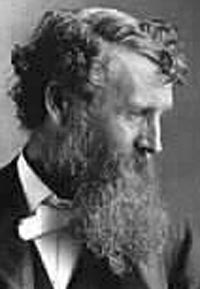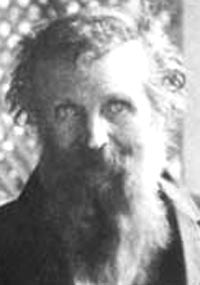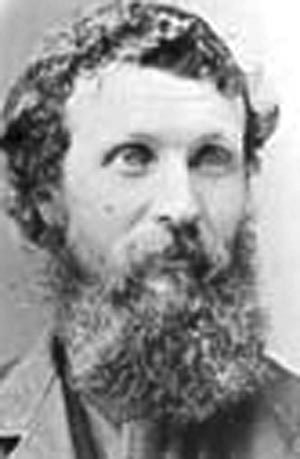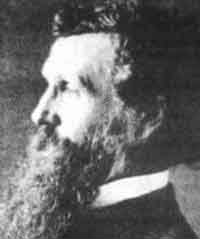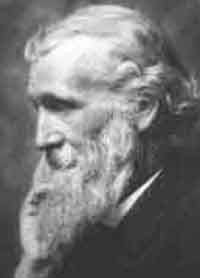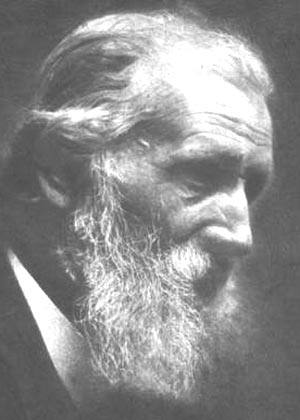Copyright Michael D. Robbins 2005
Astro-Rayological
Interpretation & Charts
Quotes
Biography
Images and Physiognomic Interpretation
I only went out for a walk, and finally concluded to stay out till sundown, for going out, I found, was really going in.
My fire was in all its glory about midnight, and, having made a bark shed to shelter me from the rain and partially dry my clothing, I had nothing to do but look and listen and join the trees in their hymns and prayers.
God never made an ugly landscape. All that the sun shines on is beautiful, so long as it is wild.
So extraordinary is Nature with her choicest treasures, spending plant beauty as she spends sunshine, pouring it forth into land and sea, garden and desert. And so the beauty of lilies falls on angels and men, bears and squirrels, wolves and sheep, birds and bees....
How infinitely superior to our physical senses are those of the mind! The spiritual eye sees not only rivers of water but of air. It sees the crystals of the rock in rapid sympathetic motion, giving enthusiastic obedience to the sun's rays, then sinking back to rest in the night. The whole world is in motion to the centre. So also sounds. We hear only woodpeckers and squirrels and the rush of turbulent streams. But imagination gives us the sweet music of tiniest insect wings, enables us to hear, all around the world, the vibration of every needle, the waving of every bole and branch, the sound of stars in circulation like particles in the blood.
Everything is flowing -- going somewhere, animals and so- called lifeless rocks as well as water. Thus the snow flows fast or slow in grand beauty-making glaciers and avalanches; the air in majestic floods carrying minerals, plant leaves, seeds, spores, with streams of music and fragrance; water streams carrying rocks... While the stars go streaming through space pulsed on and on forever like blood ... in Nature's warm heart.
When we try to pick out anything by itself, we find it hitched to everything else in the Universe.
Who publishes the sheet-music of the winds or the music of water written in river-lines?
Winds are advertisements of all they touch, however much or little we may be able to read them; telling their wanderings ever by their accents alone.
Let children walk with Nature, let them see the beautiful blendings and communions of death and life, their joyous inseparable unity, as taught in woods and meadows, plains and mountains and streams of our blessed star, and they will learn that death is stingless indeed, and as beautiful as life.
Most people are on the world, not in it. - have no conscious sympathy or relationship to anything about them - undiffused, separate, and rigidly alone like marbles of polished stone, touching but separate.
One touch of nature ... makes all the world kin.
Only by going alone in silence, without baggage, can one truly get into the heart of the wilderness. All other travel is mere dust and hotels and baggage and chatter. .
The clearest way into the Universe is through a forest wilderness.
John Muir (April 21, 1838 - December 24, 1914) was an environmentalist, naturalist, traveler, writer, and scientist. He is, however, probably best remembered as one of the greatest champions of the Yosemite area's natural wonders. He thought that nature was the outward manifestion of God and that the Sierra Nevada was sacred ground, even calling it the "Range of Light." Anticipating the animal rights movement, Muir argued with vigor about what he considered the questionable ethics of hunting (calling it the "murder business"). He also anticipated modern conservation biologists by recognizing that everything in nature is connected and that the preservation of large tracts of unfragmented wilderness was the only real way to ensure a healthy ecosystem. Because of this, he argued for the protection of entire river drainages, instead of isolated valleys.
Muir was born in Dunbar, East Lothian, Scotland and grew up on a Wisconsin farm. He attended the University of Wisconsin for several years, but instead of graduating from a school built by the hand of man, Muir opted to enroll in the "university of the wilderness" and thus walked a thousand miles from Indiana to Florida. He had planned to continue on to South America, but was stricken by malaria and went to California instead.
Arriving in San Francisco in March 1868, Muir immediately left for a place he had only read about called Yosemite. After seeing Yosemite Valley for the first time he was captivated, and wrote, "No temple made with hands can compare with Yosemite," and "[Yosemite is] the grandest of all special temples of Nature."
After his initial eight-day visit, he returned to the Sierra foothills and became a ferry operator, sheepherder and bronc buster. In May 1869 a rancher named Pat Delaney offered Muir a summer job in the mountains to accompany and watch over Delaney's sheep and sheepherder. Muir enthusiastically accepted the offer and spent that summer with the sheep in the Yosemite area. That summer Muir climbed Cathedral Peak, Mount Dana and hiked the old Indian trail down Bloody Canyon to Mono Lake. During this time he started to develop his theories about how the area developed and how its ecosystem functioned.
Now more enthusiastic about the area than before, Muir secured a job operating a sawmill in the Yosemite Valley under the supervision of innkeeper James Hutchings. A natural born inventor, Muir designed a water-powered mill to cut wind-felled trees and he built a small cabin for himself along Yosemite Creek.
Pursuit of his love of science, especially geology, often occupied his free time and he soon became convinced that glaciers had sculpted many of the features of the valley and surrounding area. This notion was in stark contradiction to the accepted theory of the day, promulgated by Josiah Whitney (head of the California Geological Survey), which attributed the formation of the valley to a catastrophic earthquake. As Muir's ideas spread, Whitney would try to discredit Muir by branding him as an amateur and even an ignoramus. The premier geologist of the day, Louis Agassiz, however, saw merit in Muir's ideas, and lauded him as "the first man who has any adequate conception of glacial action."
In 1871 Muir discovered an active cirque glacier below Merced Peak, which further helped his theories to gain acceptance. He was also a highly productive writer and had many of his accounts and papers published as far away as New York. Also that year, one of Muir's heroes, Ralph Waldo Emerson, arrived in Yosemite and sought Muir out.
A large earthquake centered near Lone Pine, California in Owens Valley (see 1872 Lone Pine earthquake) was felt very strongly in Yosemite Valley in March 1872. The quake woke Muir in the early morning and he ran out of his cabin without fear exclaiming, "A noble earthquake!" Other valley settlers, who still adhered to Whitney's ideas, feared that the quake was a prelude to a cataclysmic deepening of the valley. Muir had no such fear and promptly made a moonlit survey of new talus piles created by earthquake-triggered rockslides. This event led more people to believe in Muir's ideas about the formation of the valley.
In addition to his geologic studies, Muir also investigated the living Yosemite area. He made two field studies along the western flank of the Sierra of the distribution and ecology of isolated groves of Giant Sequoia in 1873 and 1874. In fact, in 1876 the American Association for the Advancement of Science published a paper Muir wrote about the trees' ecology and distribution.
Muir's attention soon started to switch from studying the Yosemite area and Sierra to protecting it. A precipitating event for him was the discovery of a sign illegally claiming private ownership in Kings Canyon, and loggers cutting down ancient Giant Sequoia groves south of present day Sequoia National Park.
Muir threw himself into his new role with great vigor. He saw the greatest threat to the Yosemite area and the Sierras to be livestock, especially domestic sheep (calling them "hooved locusts"). In June 1889, the influential associate editor of Century magazine, Robert Underwood Johnson, camped with Muir in Tuolumne Meadows and saw first hand the damage a large flock of sheep had done to the grassland. Johnson agreed to publish any article Muir wrote on the subject of excluding livestock from the Sierra high country. He also agreed to use his influence to introduce a bill to Congress that would make the Yosemite area into a national park, modeled after Yellowstone National Park.
A bill essentially following recommendations that Muir put forward in two Century articles ("The Treasure of the Yosemite" and "Features of the Proposed National Park", both published in 1890), was passed by Congress on September 30, 1890. To the dismay of Muir, however, the bill left Yosemite Valley in state control.
With this partial victory under his belt, Muir helped form an environmental organization called the Sierra Club on May 28, 1892 and was elected as its first president (a position he held until his death 22 years later).
Muir later befriended another leader in the conservation movement named Gifford Pinchot. That friendship was ended in the summer of 1897 when Pinchot expressed his opinion that forests should be managed for the betterment of mankind, while Muir wanted to preserve nature in its natural state. This philosophical divide soon expanded and split the conservationist movement into two camps: the preservationists, led by Muir, and Pinchot's camp, who co-opted the term "conservationist."
In 1903 President Theodore Roosevelt accompanied Muir on a visit to the park. Muir joined Roosevelt in Oakland for the train trip to Raymond. The presidential entourage then traveled by stagecoach into the park. While traveling to the park, Muir told the president about state mismanagement of the valley and rampant exploitation of the valley's resources. Even before they entered the park, he was able to convince Roosevelt that the best way to protect the valley was through federal control and management.
After entering the park and seeing the magnificent splendor of the valley, the president asked Muir to show him the real Yosemite. Muir and Roosevelt set off largely by themselves and camped a few ranges into the backcountry. While circling around a fire, the duo talked late into the night, slept in the brisk open air and were dusted by a fresh snowfall in the morning - a night Roosevelt never would forget.
Muir then increased efforts by the Sierra Club to consolidate park management and was rewarded in 1905 when Congress transferred the Mariposa Grove and Yosemite Valley into the park.
Pressure then started to mount to dam the Tuolumne River for use as a water reservoir for San Francisco. The damming of Hetch Hetchy Valley was passionately opposed by Muir who called Hetch Hetchy a "second Yosemite." Muir, the Sierra Club and Robert Underwood Johnson fought against inundating the valley and Muir even wrote Roosevelt pleading for him to scuttle the project. After years of national debate that polarized the nation, Roosevelt's successor, Woodrow Wilson signed the dam bill into law on December 19, 1913. Muir died soon afterward, some say from sorrow.
1838 -- April 21, birthday of John Muir, born in Dunbar, Scotland.
1841 -- Began school at the age of three.
1849 -- Immigration to Wisconsin at the age of 11.
1860 -- Left home (22 years of age) to exhibit his inventions at State Agriculture Fair in Madison , Wisconsin; brief jobs; enrolls at the University of Wisconsin.
1861-62 -- Attends University of Wisconsin for 2-1/2 years (5 tri-semesters), teaches school during the winter, forms friendship with the Carr's.
1863 -- Left the University; foot tour of Wisconsin, Iowa , Illinois, and Canada.
1866 -- Indianapolis, Indiana : worked for manufacturer of carriage parts.
1867 -- Eye injury. Begins 1000 mile walk to Florida and then to Cuba.
1868 -- Voyage to California: landed in San Francisco, March 28, and walked across the valley; worked at ranch of Pat Delaney.
1869 -- Summer sheep herder in high Sierra; returned to live in Yosemite, to work for Hutchings, to operate saw mill; began exploration for signs of glaciers.
1871 -- Met Emerson in Yosemite.
1872 -- Began to publish articles in leading magazines.
1873 -- Continuous residence in Yosemite ended.
1874 -- Met the Strentzels in Alhambra Valley.
1875 -- Lived in Bay Area writing magazine articles; trips to mountains; Utah .
1879 -- Proposed to Louie Strentzel; First Alaska trip with S. Hall Young; discovery of Glacier Bay and Muir Glacier.
1880 -- April 14: marriage of John Muir (42) and Louie Strentzel (33); Second trip to Alaska, adventure with Stickeen .
1881 -- John Swett bought ranch adjoining Muir holdings. Birth of Wanda Muir; railroad built; third trip to Alaska aboard the Corwin.
1882-83 -- Construction of mansion.
1882 -- Beginning of extensive ranching period.
1886 -- Birth of Helen Muir.
1888 -- Trip to Mt. Rainier ; editor and contributor of Picturesque California, two volumes.
1890 -- Alaska trip to Muir Glacier; death of Dr. Strentzel; Muir family move to mansion.
1890 -- Yosemite becomes a National Park.
1892 -- Founding of the Sierra Club , end of ranching career for John Muir.
1893 -- Trip to Europe with William Keith.
1894 -- Mountains of California published.
1898 -- Death of Mrs. Strentzel.
1899 -- Mt. Rainier National Park established; member of Harriman Alaska Expedition.
1901 -- Our National Parks published.
1903 -- Theodore Roosevelt visited Yosemite.
1904 -- World tour.
1905 -- Helen ill, Adamana, Arizona for recovery.
1906 -- Petrified Forest becomes a national monument; death of Louie Strentzel Muir, August 6.
1906 -- San Francisco earthquake, repair of house, marriage of Wanda to Thomas Hanna.
1908 -- Grand Canyon National Park established.
1907-1913 -- Fight to save Hetch Hetchy Valley; Stickeen (1909), My First Summer in the Sierra (1911), The Yosemite (1912), and The Story of My Boyhood and Youth (1913) published.
1910 -- Helen married Buel Funk.
1911-12 -- Trip to South America and Africa (73 years old.)
1914 -- December 24: death of John Muir of pneumonia in a Los Angeles Hospital.
1838 Born April 21st in Dunbar, Scotland.
1841 Starts school at the age of three.
1845 Dunbar Grammar School: taught Latin, French, English, Maths, Geography
1849 Emigrates in February by sailing ship from Glasgow; 6 weeks to New York thence via Great Lakes and wagon to Fountain Lake Wisconsin.
1850 From age 11 to 21 John Muir works on his father's farm; receives no formal schooling but teaches himself maths, geometry, literature and philosophy.
1853 Ploughboy-inventor constructs clocks, barometers, hydrometers, table-saws etc.
1860 Exhibits inventions at State Fair in Madison; enrols at the University of Wisconsin.
1861-2 Attends University of Wisconsin for almost 3 years; teaches school in winter.
1863 Leaves university; returns to Fountain Lake awaiting draft for the American Civil War.
1864 To avoid the draft he travels to Canada and remains for 2 years. Works as mechanic in sawmill at Meaford. Factory burns down March 1866; Muir returns to USA.
1866 Employed as foreman-engineer at carriage factory, Indianapolis; automates machinery
1867 Blinded in factory accident. After weeks of agony his sight returns. Sets out on a 1000 mile walk to Florida and Cuba.
1868 Sails to California via Panama Canal: lands in San Francisco, March 28. First visit to Yosemite from April - June.
1869 Summer shepherd at Tuolomne Meadows in the High Sierra
Starts to hike, climb and study the Sierra Ranges and glaciers. Carries out first ascent of Cathedral Peak in Yosemite.
1871 Ralph Waldo Emerson visits Muir in Yosemite.
1871 Publishes first article on glaciers in New York Tribune.
1872 Asa Gray, Professor of Botany at Harvard visits Muir in Yosemite. Makes first ascent of Mt. Ritter (13,000 ft.) via the North face.
1873 Solo-climbs Mt. Whitney (14,500 ft.); first recorded ascent by eastern route.
1874 Solo ascent of Mt. Shasta (14,400 ft.).
1875 Lives in Bay Area writing magazine articles; climbs Mt. Shasta and Mt. Whitney.
1876 Begins to write and lobby in public for forest protection and conservation. Guides U.S. Geodetic Survey of Nevada and Utah mountains.
1877 Leads Prof. Asa Gray and Sir Joseph Hooker of Kew on expedition to Shasta
1879 First Alaska trip. Discovers Glacier Bay and Muir Glacier; names Geikie and Hugh
Miller Glaciers.
1880 Second trip to Alaska; marries Louie Strentzel, April 14.
1881 Third trip to Alaska aboard the Corwin; birth of Wanda Muir
1882 Construction of Martinez mansion.
1882 Muir becomes a rancher and fruit farmer for 8 years.
1885 Daniel Muir dies with John Muir at his bedside.
1886 Birth of Helen Muir.
1888 Trip to Puget Sound and Mt. Shasta; climbs Mt. Rainier (14,500 ft)
1890 Fourth Alaska trip; 10 day solo-expedition by sled across Muir Glacier; Yosemite becomes a National Park. Muir campaigns for Kings Canyon and Sequoia National Parks.
1892 Co-forms the Sierra Club; serves as President until his death in 1914
1893 Trip to Europe: Edinburgh, Dunbar, London, Ireland, Norway, Switzerland, France, Italy. Campaigns for creation of Rainier National Park.
1894 Muir's first book, The Mountains of California, published.
1896 Joins U.S. Forestry Commission on survey of Yellowstone, Black Hills, Idaho, Oregon and Washington forests. Later surveys the Cascades, Santa Lucia coast ranges, southern California mountains, Grand Canyon and Southern Sierra. Fifth trip to Alaska.
1897 Awarded honorary degree by University of Wisconsin.
Sixth trip to Alaska; 5 weeks via Banff and Canadian Rockies.
1898 Forestry Commission survey of North Carolina, Tennessee, Alabama, Kentucky &
Delaware. John Muir also tours Montreal, St. Lawrence River, Maine and Vermont mountains.1899 Mt. Rainier National Park established; seventh trip to Alaska with the Harriman
Expedition to Wrangell, Glacier Bay, Sitka & Prince William Sound.
1901 'Our National Parks' published.
1903 President Roosevelt spends 3 days and nights camping alone with Muir in Yosemite.
1903 World tour: London, Paris, Holland, Berlin, Russia, Korea, Japan, China, India, Egypt, Ceylon, Australia, New Zealand, Malaya, Philippines, Hong Kong, Hawaii. At 65 he climbs the Mueller Glacier on Mt.Cook, New Zealand.
1905 Daughter Helen ill; travels with Muir to Arizona for recovery. Studies Petrified Forest; campaigns for its protection.
1906 Petrified Forest becomes a National Monument; death of Louie Strentzel Muir.
1906 San Francisco earthquake.
1908 Grand Canyon National Park and Muir Woods National Monument established.
1907 Muir begins fight to save Hetch Hetchy Valley.
1909 'Stickeen' published; Muir leads President Taft through Yosemite.
1911 'My First Summer in the Sierra' published; awarded honorary degree by Yale.
Year long trip to South America and Africa: Rio De Janeiro, and Buenos Aires, the Amazon, Chile, Uruguay, Capetown, Zambesi, Lake Victoria, Egypt.
1912 'The Yosemite' is published.
1913 Hetch Hetchy battle is lost; valley granted to San Francisco for water reservoir.
'Story of my Boyhood and Youth' published; honorary degree from University of California.
1914 John Muir dies in Los Angeles Hospital from pneumonia on Christmas eve.
